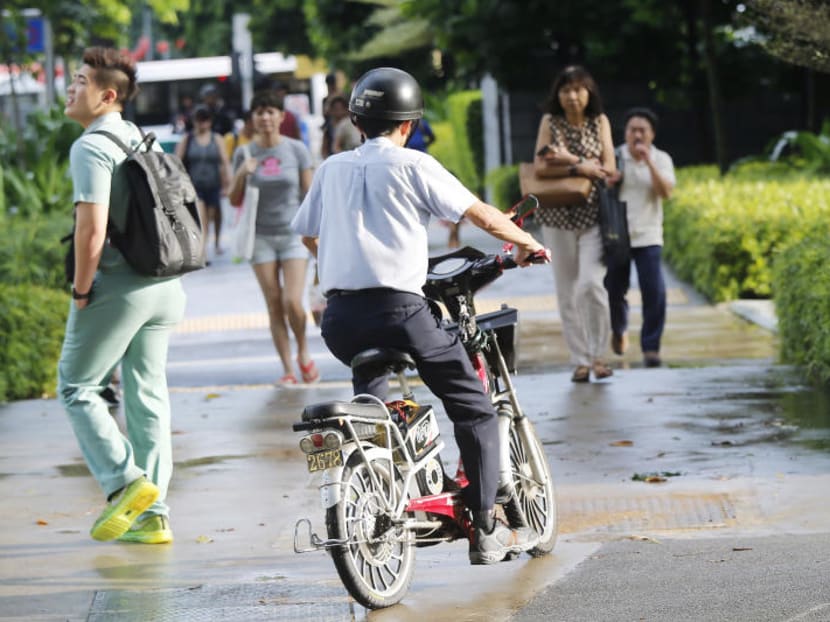Reduce speed limits on footpaths, make it compulsory for cyclists to wear helmets on roads: Panel
SINGAPORE – Reducing speed limits on footpaths to 10km/h and making it compulsory for cyclists to wear helmets on roads are among new proposals made to boost safety for public path users, given the rising number of accidents involving personal mobility devices (PMDs) and bicycles.

Among the recommendations put up by the Active Mobility Advisory Panel include lowering the speed limit on footpaths for active mobility riders from the current 15kmh to 10kmh to give riders more reaction time to prevent accidents, and to reduce severity of injuries when accidents do occur.
SINGAPORE – Reducing speed limits on footpaths to 10km/h and making it compulsory for cyclists to wear helmets on roads are among new proposals made to boost safety for public path users, given the rising number of accidents involving personal mobility devices (PMDs) and bicycles.
Releasing its recommendations on Friday (Aug 24), the Active Mobility Advisory Panel also suggested introducing a maximum speed limit of 10km/h for motorised wheelchairs and mobility scooters. This is to prevent abuse of such mobility aids by able-bodied people seeking to circumvent the e-scooter registration regime, said the panel, chaired by Associate Professor Mohammad Faishal Ibrahim, Senior Parliamentary Secretary for Education and Social and Family Development.
The Ministry of Transport said it will study recommendations made by the 14-member panel and issue its response in due course.
Other suggestions include making it compulsory for PMD users and cyclists to stop and look out for oncoming traffic at road crossings.
But the panel decided against proposing that third-party liability insurance be made mandatory despite recent calls to do so. Members of Parliament as well as the public have pointed out the inadequate compensation for accident victims involving PMDs.
Making such insurance compulsory “may significantly reduce the uptake of active mobility”, said the panel, adding instead that “greater focus should be placed on the upstream prevention of accidents”.
Assoc Prof Faishal said in a Facebook post that the latest round of recommendations were made following extensive public feedback in April and May this year.
Aside from a survey that garnered over 6,000 responses, there were focus group discussions involving some 100 participants as well as a travel diary activity where 100 users were asked to use different active mobility devices on public paths and provide feedback.
This is the second review to improve safety on public paths put forth by the panel. In 2016, it proposed a code of conduct for cycling and the use of PMDs. And in March this year, it suggested that the authorities expand mandatory registration for PMDs to include electric scooters.
RISING NUMBER OF ACCIDENTS
A growing number of reckless e-scooter riders have endangered themselves and other users of paths and roads, leading to a significant increase in the number of reported accidents involving PMDs, bicycles and power-assisted bicycles on public paths, the panel said.
From 19 in 2015, the number grew to 42 in 2016 and 128 last year.
Panel member Steven Lim, who is the president of the Safe Cycling Task Force, told TODAY that the issue of PMD users speeding on footpaths was a hot topic during the focus group discussions. Some participants wanted the speed limit be reduced to below 10km/h.
Previously, the panel had suggested a speed limit of 15km/h, but this is seen as “too fast” for footpaths, according to public feedback. With the new proposed speed limit, Dr Faishal said that it could give riders more reaction time to prevent accidents, and “to reduce the severity of injuries in the event of an accident”.
Asked why the panel decided only now to suggest mandating the use of helmets for cyclists on the roads, Mr Lim noted that some cyclists have taken this safety aspect for granted.
“They think that just because they cycle slowly, they wouldn’t get into an accident. So, they do not see the need to wear helmets. But we want to emphasise the importance of this, so we proposed making it mandatory,” he added.
The panel does not recommend making it mandatory to use helmets off-road, where speeds are slower and cyclists are not considered the more vulnerable party. Cyclists and PMD users on footpaths and shared paths are, however, encouraged to don helmets for their own safety.
The panel does not intend for the mandatory helmet rule to apply to riders who are crossing the road as part of their journey on footpaths and cycling/shared paths, or riders who are temporarily on the road to avoid an obstruction.
THIRD-PARTY INSURANCE ENCOURAGED
While it did not propose having mandatory third-party insurance, the panel said it “strongly encourages” voluntary purchase of such insurance.
To increase the take-up rate for the insurance, the panel noted that the Land Transport Authority could work with the Workplace Safety and Health Council to encourage goods-delivery companies to equip their drivers with such insurance.
Some companies such as Deliveroo have personal and third-party liability insurance for all their riders, covering any third-party claims against riders in the event of an accident during the course of the riders’ work.
The panel also suggested LTA engage retailers to offer third-party liability insurance with the sale of active mobility devices. Another proposal is to raise awareness and accessibility on avenues to seek recourse, such as mediation or civil suits. For instance, its processes can be explained in a simplified manner.
Mr Gopinath Menon, panel member and Nanyang Technological University senior research fellow, said active mobility has been a step-by-step process, starting with infrastructure and progressing to the regulation of speed limits and weights of personal mobility devices, education and legislation.
“Taking up of compulsory insurance is yet another measure that could be considered. It has not been mandated, but it will be encouraged. It is left to the insurance community to take this opportunity to promote taking up of insurance among active mobility users,” said Mr Menon.






